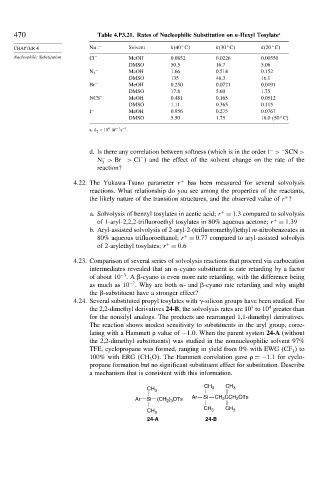Page 489 - Advanced Organic Chemistry Part A - Structure and Mechanisms, 5th ed (2007) - Carey _ Sundberg
P. 489
470 Table 4.P3.21. Rates of Nucleophilic Substitution on n-Hexyl Tosylate a
CHAPTER 4 Nu − Solvent k 40 C k 30 C k 20 C
Nucleophilic Substitution Cl − MeOH 0.0852 0.0226 0.00550
DMSO 50.5 16.7 5.06
−
N 3 MeOH 1.66 0.514 0.152
DMSO 135 48.3 16.1
Br − MeOH 0.250 0.0721 0.0191
DMSO 17.8 5.60 1.75
NCS − MeOH 0.481 0.165 0.0512
DMSO 1.11 0.365 0.115
I − MeOH 0.956 0.275 0.0767
DMSO 5.50 1.75 16.0 50 C
4
a. k 2 ×10 M −1 −1
s .
−
−
d. Is there any correlation between softness (which is in the order I > SCN >
−
N > Br > Cl ) and the effect of the solvent change on the rate of the
−
−
3
reaction?
4.22. The Yukawa-Tsuno parameter r + has been measured for several solvolysis
reactions. What relationship do you see among the properties of the reactants,
the likely nature of the transition structures, and the observed value of r ?
+
+
a. Solvolysis of benzyl tosylates in acetic acid; r = 1 3 compared to solvolysis
+
of 1-aryl-2,2,2-trifluoroethyl tosylates in 80% aqueous acetone; r = 1 39
b. Aryl-assisted solvolysis of 2-aryl-2-(trifluoromethyl)ethyl m-nitrobenzoates in
+
80% aqueous trifluoroethanol; r = 0 77 compared to aryl-assisted solvolyis
of 2-arylethyl tosylates; r = 0 6
+
4.23. Comparison of several series of solvolysis reactions that proceed via carbocation
intermediates revealed that an
-cyano substituent is rate retarding by a factor
−3
of about 10 .A -cyano is even more rate retarding, with the difference being
−7
as much as 10 . Why are both
- and -cyano rate retarding and why might
the -substituent have a stronger effect?
4.24. Several substituted propyl tosylates with -silicon groups have been studied. For
4
3
the 2,2-dimethyl derivatives 24-B, the solvolysis rates are 10 to 10 greater than
for the nonsilyl analogs. The products are rearranged 1,1-dimethyl derivatives.
The reaction shows modest sensitivity to substituents in the aryl group, corre-
lating with a Hammett
value of −1 0. When the parent system 24-A (without
the 2,2-dimethyl substituents) was studied in the nonnucleophilic solvent 97%
TFE, cyclopropane was formed, ranging in yield from 0% with EWG CF to
3
100% with ERG CH O . The Hammett correlation gave
=−1 1 for cyclo-
3
propane formation but no significant substituent effect for substitution. Describe
a mechanism that is consistent with this information.
CH 3 CH 3 CH 3
Ar Si (CH ) OTs Ar Si CH CCH OTs
2
2
2 3
CH CH
CH 3 3 3
24-A 24-B

